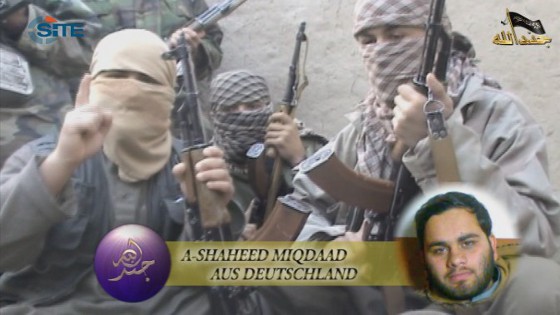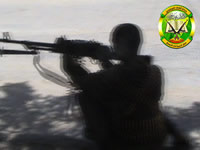Southeast Asian jihadist leader and bomb expert is alive, in Philippines
Zulkifli bin Hir, a most-wanted terrorist linked to Jemaah Islamiyah, Abu Sayyaf, and the KMM who was reported killed in 2012, is operating in the southern Philippines.
Zulkifli bin Hir, a most-wanted terrorist linked to Jemaah Islamiyah, Abu Sayyaf, and the KMM who was reported killed in 2012, is operating in the southern Philippines.
In well over a dozen countries, evidence has emerged that jihadists who trained or fought in Syria are engaging in terrorist activities in their home countries and elsewhere.
Arrests and raids in seven Turkish provinces involving suspected al Qaeda leaders as well as the Islamist charity IHH Humanitarian Relief Foundation suggest that the Erdogan government is determined to disprove allegations that it tacitly supports al Qaeda in Syria.
A “German Camp” that caters to training and recruitment and serves as a magnet to attract German-speaking jihadists from Europe has been established in Syria.
Mediation by Kuwaiti and Qatari clerics may result in an agreement normalizing relations between Hamas and Salafi jihadists. Tensions between Hamas and Salafi jihadists have increased sharply over the past year.
Sweden, like much of the West, has been slow to grapple with the realities of the Syrian conflict, including the likelihood that seasoned jihadists will return home from Syria.
Jihadists have launched 12 suicide bombings and assaults in Mali since the beginning of February.
As Islamist recruiters capitalize on the West’s fumbling and belated response to the Syrian conflict, jihadists from Europe and elsewhere are flocking to Syria, with potentially serious long-term consequences.
“The arrival of hundreds of young mujahideen from different areas across the Islamic world to support us in our war against the infidels and crusaders is not strange or surprising,” Ansar Dine’s spokesman said.
Foreign jihadists from West African countries such as Togo, Benin, Niger, Nigeria, Guinea, Senegal, and the Ivory Coast are filling out the ranks.
The jihadist media outlet is likely linked to the Haqqani Network, and may cater to foreign fighters.
 The Haqqani Network suicide assault on a major US base in Khost was promoted by the Taliban on their propaganda website.
The Haqqani Network suicide assault on a major US base in Khost was promoted by the Taliban on their propaganda website.
Samir H., a known “Islamist” from Aachen, is said to have been killed in the March 9 strike in Makeen in South Waziristan.
 Sinan Tekin, a Turkish national who was known as Emir Yunis, led a group of foreign fighters along the Afghan-Pakistani border.
Sinan Tekin, a Turkish national who was known as Emir Yunis, led a group of foreign fighters along the Afghan-Pakistani border.
Abu ‘Asim al Tabuki Mansour Nasser al Bihani waged jihad in Bosnia, Dagestan, Chechnya, Afghanistan, Yemen, and Somalia. He trained Omar Hammami, the American military commander in Shabaab. Two of Abu ‘Asim’s brothers are currently being held at the Guantanamo Bay detention facility.
Another Turkish fighter is said to have been killed in a recent US Predator airstrike in Mir Ali, Pakistan.
Moezeddine Garsallaoui, a Swiss citizen originally from Tunisia who is now thought to be a senior al Qaeda operative in North Waziristan, said the elections are a Western trick designed to usurp the establishment of a global caliphate.
The Islamic Movement of Uzbekistan said that Abu Bakr al Almani, a previously unknown jihadist, was killed during battle.
Abu Zarr fought in the Caucasus for 15 years before traveling to Afghanistan and joining the Taifatul Mansura. The Taliban executed him for ordering the deaths of two “foreign fighters.”
 Miqdad, a German citizen who is also known as “Abdullah the Essen,” was killed while fighting US forces in Baghlan in April 2011. He wanted “to kill Germans.”
Miqdad, a German citizen who is also known as “Abdullah the Essen,” was killed while fighting US forces in Baghlan in April 2011. He wanted “to kill Germans.”
The Voice of Jihad did not answer queries as to why an old interview with the leader of the Haqqani Network was republished.
The IJG facilitator “is responsible for coordinating the movement of foreign fighters from Iran and Pakistan into Afghanistan,” ISAF stated.
Since the end of the summer, several African Union officials have claimed that Shabaab and Hizbul Islam were being driven back in Mogadishu. These reports coincided with claims that a serious rift had developed between Shabaab’s top two leaders. The claims of a split in Shabaab proved false, and, based on this report from The […]
The commander, who is known as Qureshi, is said to have been killed in yesterday’s second strike in the Datta Khel area in North Waziristan.
 A five-man assault team penetrated the first layer of security at Mogadishu International Airport. Two African Union soldiers and three civilians were killed.
A five-man assault team penetrated the first layer of security at Mogadishu International Airport. Two African Union soldiers and three civilians were killed.
Last week’s Shabaab bombing attacks in Uganda were designed to undermine that country’s support for the African Union Mission in Somalia. Ugandan support or not, AMISOM is underfunded and there are significant questions about whether peacekeeping is suitable for Somalia.
Shabaab commander Sheikh Abu Mukhtar Robow (left) and former al Qaeda leader Saleh Ali Saleh Nabhan (faced covered) in a propaganda video acquired by The Long War Journal. US Special Operations Forces killed Nabhan in a raid in September 2009. Nabhan was one of the top leaders in Shabaab and worked to integrate the group […]
 Al Qaeda’s leader praised Shabaab and called for the downfall of the government led by former Islamic Courts leader Sheikh Sharif Ahmed. This is the third tape on Somalia released by senior al Qaeda leaders since Feb. 13.
Al Qaeda’s leader praised Shabaab and called for the downfall of the government led by former Islamic Courts leader Sheikh Sharif Ahmed. This is the third tape on Somalia released by senior al Qaeda leaders since Feb. 13.
 The Long War Journal’s roundup of the major developments in the primary and secondary theaters during the past year.
The Long War Journal’s roundup of the major developments in the primary and secondary theaters during the past year.
A year-end roundup of the major developments in the Long War in the primary and secondary theaters across the globe.